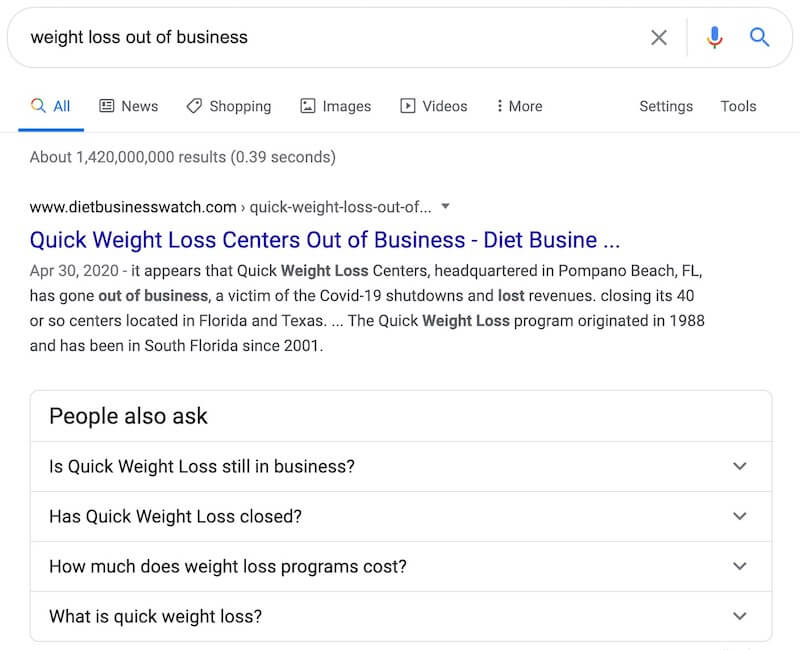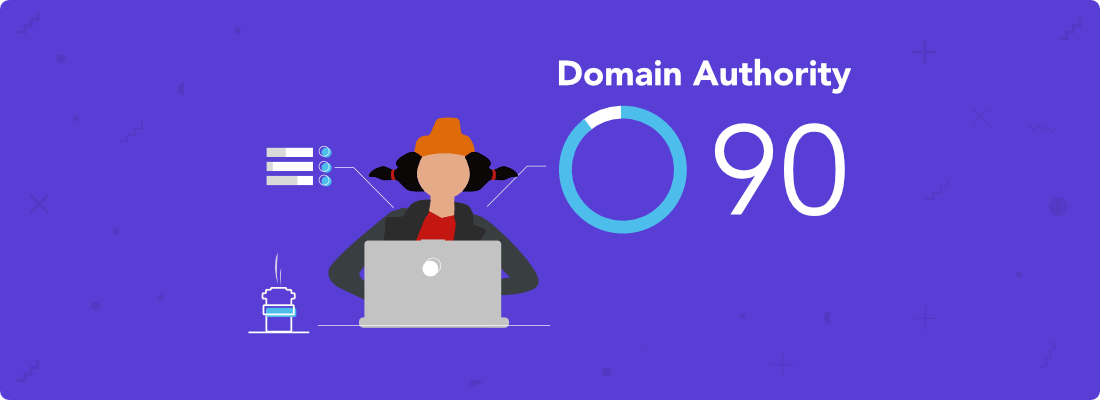If you’re looking to increase your domain authority (DA), you can get started by:
- Auditing your link profile (removing spammy backlinks)
- Creating high-quality and engaging content
- Earning quality backlinks
- Getting more traffic from other sources
In this article, we’ll take a deep dive into each one of these so you can get your site ranking high in search engine result pages (SERPs).
After that, we’ll go over some other important details about domain authority you should know about.
Contents
- Audit your link profile
- Create high-quality content
- Get high-quality backlinks
- Get traffic from other sources
- What is domain authority?
- How is domain authority calculated?
- How to check your domain authority
- What is a good domain authority?
- Domain authority isn’t the be-all and end-all of SEO
- Other FAQs about domain authority
Disclosure: You should always assume that pretty much every link on this site is an affiliate link, and if you click it and buy something you like, I’ll earn some money to help me buy a DeLorean, build a time machine, and travel back to the 90s so I can watch Hey Arnold! and eat Dunkaroos again.
Step 1: Audit Your Link Profile
If you want to increase your domain authority, you must keep a healthy link profile.
A link profile is all the backlinks your site has gotten over the years.
Getting a massive number of backlinks from different sites will let Google know that your site is authoritative, trustworthy, and cool.
However, this doesn’t mean you should go ask a bunch of random sites for backlinks.
Google wants those links to be “healthy” or “natural” links. A healthy link profile is one that follows Google’s guidelines.
Any links intended to manipulate a site’s ranking in Google is referred to by them as “link schemes” and can get you penalized.
Here are a few ways people try to fool Google:
- Paying for backlinks
- Paying for guest posting (some bloggers will charge you for guest posting on their sites and putting a backlink to yours)
- Exchanging links in groups or forums
- Using bots to create backlinks
- Using text ads to pass PageRank
- And more
If you’ve gotten a few backlinks in an unnatural way, consider removing most of them if you want search engines to see your site as an authority.
Besides, if you’re buying backlinks, chances are most of them are not even related to your niche or high-quality.
So they aren’t doing much to increase your domain authority or help your SEO anyway.
How to Do a Link Profile Audit
To check your website’s link profile, you can use free tools like:
After checking your link profile, you want to disavow spammy and unrelated links from your site using a tool like Disavow Tool from Google.
Keep in mind that this might take a while depending on how many backlinks you have.
Here’s how to do a link profile audit using Moz’s Link Explorer:
- Go to Moz’s Link Explorer
- Type your domain
- Click on Linking Domain on the left sidebar menu under Link Research
- Scroll down until you see the linking domains
You’ll only be able to see 10 linking domains. If you want to see more, you have to sign up with a free 30-day trial.
If you need more than 30 days to do this (which you shouldn’t), you can simply export the data so you can go through it even after your trial’s up.
To do this, just click on “Export CSV.”
The data will be downloaded in a CSV file you can open with Excel or Google Sheets.
What to Look for in Your Link Profile Audit
Check for links coming from sites that have a domain authority under 40.
Then, you’ll need to visit each site (be careful) and see if they’re spammy or unrelated to your niche.
Again, this might take a while depending on how many backlinks you have.
Create a .txt file on your computer and make a list of all the weird and spammy sites.

Here are some things to keep an eye for when checking the sites:
- Drug enhancement sites
- Adult themed websites
- Content in a foreign language
- Thin content
- Link farms
- Unrelated spammy sites
How to Use Google’s Disavow Tool
According to Google, you should only use the disavow tool if you have a ton of spammy sites and believe that’s causing an issue.
They say that in most cases, Google can assess which links to trust without additional guidance, so normal or typical sites might not need this tool.
So, before using Google’s disavow tool, contact the owner of the site and see if they’re willing to remove the link.
If they don’t reply or want to remove it, go ahead a disavow it.
Here’s how to disavow a list of websites:
- Go to Google’s Disavow Tool
- Select the site you want to disavow links
- Ignore the warning (the warning goes over what I just told you)
- Click choose file
- Select the .txt file you created earlier
- Click submit
That’s it, Google should take care of it within a few days.
Step 2: Create High-Quality Content
The best way to increase your domain authority is by writing high-quality blog posts.
If people love your content, they’ll come back, share it with friends or on social media, and potentially link back to it.
The more people visit your site and engage with your content, the more love you’ll get from Google and other search engines.
The more love you get from search engines, the more backlinks you can potentially get.
The more backlinks you get, the more your domain authority will increase.
How to Create Quality Content
I won’t go over everything that goes into writing a memorable and SEO blog post, but I’ll share some of the most important things.
1. Answer Your Visitor’s Question
When you hear SEO experts talk about “satisfying user intent,” this is what they mean.
Chances are someone clicked on your article because they needed help with something.
For example, if you’re reading this article, you probably have a low domain authority and want to increase it.
If you noticed, I jumped right into how to increase your domain authority.
I didn’t add a bunch of stuff on domain authority before giving you the answer you’re looking for.
Right off the bat, I told you that you needed to:
- Do a link profile audit
- Create high-quality content
- Earn quality backlinks
- Increase your traffic
And now I’m expanding on each of those.
After you’ve satisfied user intent, you can include other related questions you think they might have.
For example, after I finish telling you how to increase domain authority, you’ll see that I talk about other things like:
- What exactly is domain authority
- How is domain authority calculated
- How to check it
- Why you shouldn’t stress too much about it
- And more
Remember, blog posts are not about you, they’re about your reader and helping them with whatever issue they’re having.
2. Content Length
You’ve probably heard some SEO experts say that your blog posts should be 3,000+ words for them to rank on Google.
I’m sure you’ve also heard others say that keeping it at around 1,000 words provides better user experience and therefore will improve rankings.
The thing is… both of them are right (and wrong).
The length of your blog post will depend on your keyword and niche.
To find out how long a blog post should be, go to Google and search for your keyword.
Then, open all the articles that show up on the first page of Google and see how many words they have (don’t take into account sites like Quora, Wikipedia, or Yelp).
I use a browser extension called Word Counter Plus to quickly check word count.
You could also copy and paste the article in Word and check the word count that way.
If all the blog posts you see have around 2,000 words, then that’s around the word count you want to aim for as well.
You can write about 200-300 more words and/or add some great graphics to make your post better than the ones currently ranking.
Obviously, don’t just add a bunch of nonsense, those extra words need to provide value and set you apart.
At the end of the day, it’s still about quality, not quantity.
Don’t write more just to hit a certain word count.
3. Break Up Your Text
If your blog posts are a bunch of paragraphs without anything to distinguish between sections, your visitors won’t hesitate to bounce.
Make it easy for them to read.
Use different headings, quotes, images, tips, or designs to break up your text.
4. Use Shorter Sentences
There’s nothing more unappealing than visiting a website and seeing huge blocks of text.
So try making your paragraphs only 1 to 2 sentences long.
Using short sentences is especially important now that more people are looking at content on their phones.
5. Use a Readable Font Size
You have no idea how many websites I’ve visited where I have to hold Command (⌘) and press the plus key (+) to zoom in and be able to read anything.
And I’m only in my late 20s and don’t wear glasses.
You need to pick a font size that’s comfortable for other people to read, not just you.
I like keeping my body font size anywhere between 14-18 px, depending on the font.
Step 3: Get High-Quality Backlinks
There are several link building strategies you can use to increase your domain authority and traffic.
In this section, I’ll go over my three favorite link building strategies.
1. Guest Posting
Guest posting is one of the best ways of getting backlinks to increase your domain authority.
In case you’re not familiar with guest posting, it’s basically writing content for another website with the goal of:
- getting a link back to your site,
- getting some of their audience, and
- establishing yourself as an authority
It is definitely a time-consuming process, as you have to search for sites that are accepting guest posts, pitch your idea, and write the content.
However, it’s one of the link building strategies with the highest success rates.
Whenever you’re ready to start guest posting, you can read my step-by-step guide to walk you through the process.
2. Search and Replace
Look for posts that rank well for high difficulty keywords in your niche and see which websites are linking to them.
After finding out those websites, go ahead and write an even better blog post on that same topic and suggest those websites to link to your blog post instead.
“But, Christian… why are we looking for high difficulty keywords instead of easy ones?”
Blog posts ranking for high difficulty keywords will have more websites linking back to them, which will give you more people to reach out to.
Not many websites will agree to replace their current links with yours, so you’ll have to contact a lot of them.
Plus, if a keyword has a high difficulty, it means that that’s the content your audience wants to read.
Getting those backlinks will automatically help you rank better for keywords with a lower difficulty score.
You need more backlinks to rank for a keyword with a difficulty score of 50 than one with a score under 20.
Remember, blog posts can rank for several keywords, not just one.
How to Find a Website’s Backlinks
Websites like Ahrefs and SEMrush let you use their backlink checker for free.
Simply add the URL of the blog post you want to check and click the “check” button.
It should show you a list of all the linking domains.
How to Find Contact Information
For this, you can simply go to their contact or about page.
If you can’t find an email address that way, you can use a free tool like Hunter.io to scan the site and find all the email addresses listed.
3. The Moving Man’s Method
Brian Dean calls this next strategy the “Moving Man’s Method.”
It consists of looking for popular companies that have gone out of business or have websites that haven’t been updated in a long time and are pretty much useless.
Then, you want to find websites that are still linking to these businesses or outdated websites and suggest them to replace them with yours.
Here’s how to do it:
- Go to Google and search for a keyword related to your niche plus the search term “out of business” or “no longer available.”
- Run a backlink check on the website of the companies you find and see who’s still linking to them (you can use Ahrefs as we did on the previous method).
- Reach out to the websites still linking to them and suggest that they replace those links with yours.
For example, I typed “weight loss out of business” in Google search and found a company called Quick Weight Loss that might have gone out of business.

See how people are asking if Quick Weight Loss still in business?
Now, I can simply run the backlink check, see who’s still linking to them, and suggest replacing that link with mine.
Step 4: Get Traffic From Other Sources
Like I mentioned earlier, the more traffic you get, the higher the chances of you getting a backlink and increasing your domain authority.
The more people visit your site and spend time there, the more Google is going to see you as an authority and increase your rankings.
I use Pinterest as a way to get more traffic to my sites.
In fact, 60% of my visitors come from Pinterest.
Why Pinterest is Great for Driving Traffic
Because it’s not a social media platform like many people believe.
Pinterest is actually another search engine like Google and YouTube.
However, YouTube is better for building trust with your audience than it is for driving traffic back to your website.
Pinterest, on the other hand, focuses more on images and people have to click-through to your site to see the content.
Besides, I’m pretty sure you know you shouldn’t put all your eggs in one basket.
Pinterest can be time consuming as you have to create images and schedule Pins, but it’s far easier to rank on there than on Google.
And no, Pinterest isn’t just for women.
There are plenty of guy-focused brands doing extremely well on Pinterest, such as:
The Art of Manliness

Dollar Shave Club

Harley-Davidson

What About Instagram?
The thing about Instagram is that people can’t search for your content.
Once you post something, only a few people will see it before it gets buried in the feed.
Also, not many people will visit your website from Instagram, they typically just stay in the platform.
Instagram, just like YouTube, is better for connecting with your audience and building trust.
I have over 9,000 followers on Instagram and only get about 10-15 visits to my blog posts every time I post them on my story and bio.
However, I do get tons of engagement on my photos.
So, if you want to increase your domain authority and traffic, I recommend looking into Pinterest.
What is Domain Authority?
Now that we’re done talking about how to increase domain authority, I want cover a few other things about it.
Many people believe that having a high domain authority is the absolute answer for ranking in Google, but it isn’t.
In fact, domain authority isn’t even a metric created by Google.
It was developed by Moz, a SEO software company, as a way to predict how well a website will rank on search engine result pages (SERPs)
Domain authority scores go from 1 to 100. The higher the number, the higher the ranking chances of a website.
If you recently launched your blog, chances are your domain authority is uno.
And no, I don’t mean the pizzeria, I mean the number 1, like Arnold.

Moz scores domain authority on a 100-point, logarithmic scale.
I know, I know… that sounds like a nerdy word only an engineer would use (yes, I used it a lot in college, don’t judge me).
All you need to know is that the higher you get on the scale, the harder it is to improve.
For example, it’s easier to take your domain authority from 1 to 10, than it is from 50 to 60.
It’s just like losing weight.
The first few pounds typically come off easily, but the leaner you get, the tougher it becomes to lose weight.
How is Domain Authority Calculated?
There are several things that Moz measures to come up with a site’s domain authority.
Here are three of the most important ones:
- MozRank: This measures how popular a website is by counting the quality and quantity of websites linking back to it.
- MozTrust: This only measures the trust (quality) of the links. The more high-quality sites link to your site, the higher your MozTrust will be. For example, pages from major universities or governmental websites are considered ultra-high-quality.
- Link Profile: This looks at both internal and externals links to and from a site. A website that links to trustworthy sources, like scientific journals, and receives links from them will have a high link profile.
How to Check Your Domain Authority
You can check your (or other website’s) domain authority using Moz’s Link Explorer or their free SEO toolbar called MozBar (I like using the MozBar).
Simply head to the Moz’s website, register, and download the MozBar.
After you’ve installed it, you should see the domain authority of every website you visit on the top right corner of your browser where you have your extension icons.

You’ll also be able to see it in Google’s search results.

What is a Good Domain Authority?
Since domain authority is just a comparative score, there really isn’t a good or bad score.
Just check the domain authority scores of the sites you’re directly competing against in the SERPs and focus on getting a higher score than them.
If all domains in your niche have an authority of 20, then a domain authority of 20 and above should be good.
Use it as a comparative metric rather than an absolute concrete score.
Domain Authority Isn’t the Be-all and End-all of SEO
You should only use domain authority as a tool to keep track of your SEO progress.
When your traffic and rankings improve, your domain authority will too.
If you keep practicing good on-page SEO, link building, and social media marketing, you’ll slowly bring up your DA.
Other FAQs About Domain Authority
1. How long does it take to increase domain authority?
Short answer: it depends.
It’s difficult to give an exact answer to this question since it depends on:
- How much time and effort you put into it
- Your current domain authority
As I mentioned earlier, it’ll take less time to go from 1-10 than from 60-65.
You also need to write high-quality content and reach out to other authoritative sites to get backlinks.
If you spend all your time in link building, then you won’t be creating much content, which can delay how fast you increase domain authority.
Also, a site with high DA will boost your DA more than a low DA site.
You might be able to go from 1-20 in under a year if you work super hard.
But again, this can vary greatly.
2. What’s the difference between Domain Authority and Page Authority?
Page authority is a score created by Moz to predict how well a specific page will rank on search engine result pages (SERPs).
The difference between domain and page authority is that domain authority measures the value of your entire domain, while page authority measures the value of a single page.
However, they’re both calculated using the same metrics.
Final Thoughts on How to Increase Domain Authority
Domain authority should only be used as a comparative tool and not as your end goal.
The most important thing you must focus on is creating high-quality content. This will be the base for you to start working on increasing your domain authority.
After creating high-quality content, you can go ahead and start using some of the different link building strategies.
If you already have content on your site, make sure to clean things up by running a link profile audit and disavowing spammy and unrelated websites linking back to yours.
Remember, avoid link schemes, such as:
- Paying for backlinks
- Exchanging backlinks
- Using text ads to pass PageRank
- Paying for guest posting

